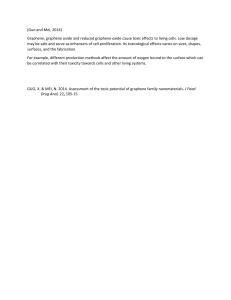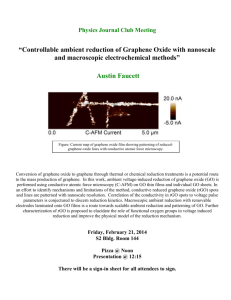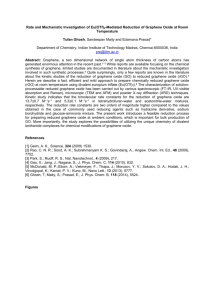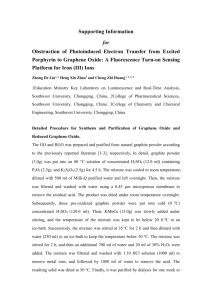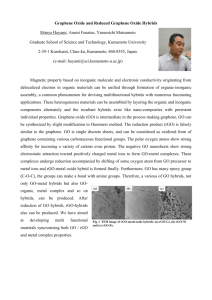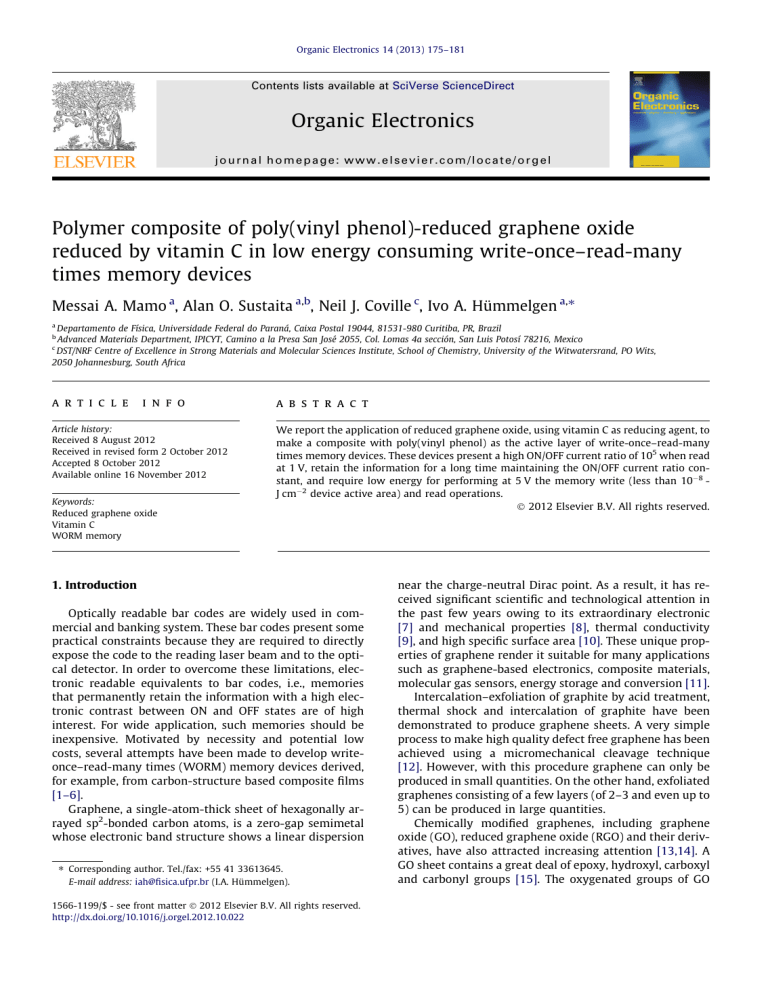
Organic Electronics 14 (2013) 175–181 Contents lists available at SciVerse ScienceDirect Organic Electronics journal homepage: www.elsevier.com/locate/orgel Polymer composite of poly(vinyl phenol)-reduced graphene oxide reduced by vitamin C in low energy consuming write-once–read-many times memory devices Messai A. Mamo a, Alan O. Sustaita a,b, Neil J. Coville c, Ivo A. Hümmelgen a,⇑ a Departamento de Física, Universidade Federal do Paraná, Caixa Postal 19044, 81531-980 Curitiba, PR, Brazil Advanced Materials Department, IPICYT, Camino a la Presa San José 2055, Col. Lomas 4a sección, San Luis Potosí 78216, Mexico c DST/NRF Centre of Excellence in Strong Materials and Molecular Sciences Institute, School of Chemistry, University of the Witwatersrand, PO Wits, 2050 Johannesburg, South Africa b a r t i c l e i n f o Article history: Received 8 August 2012 Received in revised form 2 October 2012 Accepted 8 October 2012 Available online 16 November 2012 Keywords: Reduced graphene oxide Vitamin C WORM memory a b s t r a c t We report the application of reduced graphene oxide, using vitamin C as reducing agent, to make a composite with poly(vinyl phenol) as the active layer of write-once–read-many times memory devices. These devices present a high ON/OFF current ratio of 105 when read at 1 V, retain the information for a long time maintaining the ON/OFF current ratio constant, and require low energy for performing at 5 V the memory write (less than 108 J cm2 device active area) and read operations. Ó 2012 Elsevier B.V. All rights reserved. 1. Introduction Optically readable bar codes are widely used in commercial and banking system. These bar codes present some practical constraints because they are required to directly expose the code to the reading laser beam and to the optical detector. In order to overcome these limitations, electronic readable equivalents to bar codes, i.e., memories that permanently retain the information with a high electronic contrast between ON and OFF states are of high interest. For wide application, such memories should be inexpensive. Motivated by necessity and potential low costs, several attempts have been made to develop writeonce–read-many times (WORM) memory devices derived, for example, from carbon-structure based composite films [1–6]. Graphene, a single-atom-thick sheet of hexagonally arrayed sp2-bonded carbon atoms, is a zero-gap semimetal whose electronic band structure shows a linear dispersion ⇑ Corresponding author. Tel./fax: +55 41 33613645. E-mail address: iah@fisica.ufpr.br (I.A. Hümmelgen). 1566-1199/$ - see front matter Ó 2012 Elsevier B.V. All rights reserved. http://dx.doi.org/10.1016/j.orgel.2012.10.022 near the charge-neutral Dirac point. As a result, it has received significant scientific and technological attention in the past few years owing to its extraordinary electronic [7] and mechanical properties [8], thermal conductivity [9], and high specific surface area [10]. These unique properties of graphene render it suitable for many applications such as graphene-based electronics, composite materials, molecular gas sensors, energy storage and conversion [11]. Intercalation–exfoliation of graphite by acid treatment, thermal shock and intercalation of graphite have been demonstrated to produce graphene sheets. A very simple process to make high quality defect free graphene has been achieved using a micromechanical cleavage technique [12]. However, with this procedure graphene can only be produced in small quantities. On the other hand, exfoliated graphenes consisting of a few layers (of 2–3 and even up to 5) can be produced in large quantities. Chemically modified graphenes, including graphene oxide (GO), reduced graphene oxide (RGO) and their derivatives, have also attracted increasing attention [13,14]. A GO sheet contains a great deal of epoxy, hydroxyl, carboxyl and carbonyl groups [15]. The oxygenated groups of GO 176 M.A. Mamo et al. / Organic Electronics 14 (2013) 175–181 sheets can be partly removed by chemical, electrochemical or thermal reduction process to prepare RGO [16]. More importantly, Kudin et al. [17] reported that after deoxygenation the RGO conjugated structure was restored. In the most successful cases, the chemical reduction of the GO was conducted using hydrazine or hydrazine hydrate as the reducing agent. A study by Long et al. [18] indicated that when hydrazine is used as a reducing agent, nitrogen atoms are incorporated into the structure of RGO. The N atoms are expected to enhance the conductivity of the RGO due to the lone pair of electrons associated with the nitrogen atom. However, because hydrazine and hydrazine hydrate are highly poisonous and explosive [19], researchers have sought alternative reagents. More recently, a study conducted by Fernandez-Merino et al. [20] revealed that ascorbic acid could be used as an alternative to hydrazine and is as efficient as hydrazine in the deoxygenation of graphene oxide. In this contribution we report on the development of WORM memory devices based on RGO prepared using this strategy, i.e., using vitamin C as a reducing agent. We have made a composite containing RGO and poly(vinyl phenol) (PVP) as organic medium. This composite was sandwiched between metallic electrodes and electrically characterized, demonstrating its suitability for high performance memory devices. 2. Experimental section All chemicals, except the carbon spheres, were obtained from Sigma–Aldrich and used without further purification. Graphite oxide was prepared in the form of both a thick slurry and a fine dry powder starting from natural graphite powder using the modified Hummers method, as previously reported [21]. A 9:1 mixture of concentrated H2SO4/H3PO4 (360:40 mL) was added to a mixture of graphite flakes (3.0 g, 1 wt equiv) and KMnO4 (18.0 g, 6 wt equiv). The reaction was then heated to 50 °C and stirred for 12 h. After the reaction mixture was cooled to room temperature, distilled water (400 mL) with 30% H2O2 (3 mL) was added slowly. The solution was centrifuged (7500 rpm for 20 min at 4 °C), and the supernatant was decanted away. The remaining solid material was then washed copiously with a total of 1000 mL of water and 200 mL of 30% HCl. Finally the solid material was then dissolved in 1000 mL of deionized water and centrifuged. The material remaining after this extended, multiple-wash process was coagulated with 200 mL of ether and the resulting suspension was filtered through a 1 lm pore size Teflon membrane filter. The solid obtained on the filter was vacuum-dried overnight at room temperature, to give 4.6 g of product. A procedure for the reduction of the graphene oxide was adapted from Fernandez-Merino et al. [19]. Deoxygenation of graphene oxide was conducted by dispersing the synthesized GO at a concentration of 0.1 mg mL1 in distilled water. Then the pH of the dispersion was adjusted to 9–10 with 25% ammonia solution to promote the colloidal stability of the graphene oxide sheets through electrostatic repulsion. After the solution was sonicated for about 1 h, vitamin C (2 mmol) was added as a reducing agent to the solution and the solution was heated at 95 °C under continuous stirring for 12 h. After 15 min the brown mixture started to turn dark. The reduced graphene oxide was filtered with a 1 lm pore size Teflon membrane filter and repeatedly washed with warm distilled water. Finally the reduced graphene oxide was dried under vacuum at room temperature for 24 h. The graphene oxide and reduced graphene oxide were characterized by transmission electron microscopy (TEM) using a FEI Tecnai G2 Spirit electron microscope at 120 kV. Raman spectroscopy (J-Y T64000) was used to measure the intensity of the D and G bands of the graphene oxide and reduced graphene oxide. The memory device was prepared by the simple construction of a 450 nm thick c-PVP-RGO composite film (c-PVP: crosslinked PVP) sandwiched between a 100 nm thick Al bottom and top electrode (Al/c-PVP-RGO/Al). The device active area, corresponding to the overlap of the top and bottom electrode, was 4 mm2. The thickness of the PVP film was estimated by the capacitance measurement of the c-PVP film, assuming a relative dielectric constant equal to 3.5 [22]. For the fabrication of the devices, poly(4-vinylphenol) (PVP) and methylated poly(melamine-co-formaldehyde) (PMF) as a cross-linker, were dissolved in propylene glycol monomethyl ether acetate, at concentrations equal to 7% and 2.5%, respectively. RGO was then added to the solution to prepare devices with different RGO to host polymer matrix ratios, specifically [RGO]/[PVP + PMF] w/w concentrations of 0.5%, 1%, 2% and 10%, as summarized in Table 1. The composite mixtures were sonicated for ca. 3 h at room temperature and 100 lL of suspension, in each case, was then spin-coated onto an Al electrode at 2000 rpm. The devices were then annealed in air at 200 °C for an hour in order to cross-link the polymer [23,24]. The Al metal was then thermally evaporated onto the composite surface at 106 Torr base pressure using a shadow mask for device patterning. The devices were then characterized using a programmable Keithley 2602 source meter. Table 1 Current density in both the OFF and ON state, ON/OFF current ratio and threshold voltage of the devices as a function of the composition of the composite used in the memory devices. Concentration of RGO in the c-PVP matrix (%) OFF current at 1 V (A/ cm2) ON current at 1 V (A/ cm2) ON/OFF ratio Threshold voltage (V) 10 2 1 0.5 7.8 10–8 7.3 109 6.0 1010 4.0 1010 1.9 102 8.0 104 1.7 104 1.3 104 2.5 105 1.1 105 2.8 105 3.1 105 4.0 3.8 4.0 4.0 177 M.A. Mamo et al. / Organic Electronics 14 (2013) 175–181 3. Results and discussion Graphite oxide was prepared in the form of either a thick slurry or a fine dry powder. During deoxygenation, the brown solution of graphene oxide slowly turned to black (see Fig. 1). However, reduced graphene has low solubility in water. This low solubility of the RGO sheets in water may be due to the strong p–p stacking tendency between RGO sheets that leads to the formation of irreversible agglomerates. ATR-FTIR spectra of the oxidized and reduced graphene samples are shown in Fig. 2. For unreduced graphene oxide (Fig. 1a), the following features are observed: a broad, in- tense band at 3000–3500 cm1 (OAH stretching vibrations) and narrower bands at about 1736 cm1 (C@O stretching vibrations from carbonyl and carboxyl groups), 1624 cm1 (C@C stretching, skeletal vibrations from unoxidized graphitic domains), 1420 cm1 (OAH bending vibrations from hydroxyl groups), 1220 cm1 (breathing vibrations from epoxy groups), and 872 cm1(attributed to vibrations from epoxy, ether or peroxide groups) [25,26]. For all the reduced materials (Fig. 1b), the intensities of the bands associated with oxygen functional groups strongly decreased in relation to those of unreduced graphene oxide. Moreover, the deoxygenated graphene oxide was also confirmed by ultraviolet absorption spectra, as shown in Fig. 3. The peak at 228 nm is related to the p–p electron transition in the polyene-type structure of the graphene oxide. After deoxygenation at 80 °C, only a peak centered at 267 nm was observed, indicating that the electronic conjugation of GO was restored [21]. Moreover, an absorption peak at 296 nm corresponding to the n ? p transition of the C@O bond disappeared after reduction [21]. The microscopy images of the prepared graphenes (GO and RGO) are presented in Fig. 4. The sample for TEM was prepared by dispersing a small amount of the graphene in ethanol and then drop casting over a carbon coated copper grid. The dried grid was used for TEM analysis. The removal of OH groups and other functional groups during deoxygenation results in a wrinkled structure (see Fig. 4), which gives its fluffy physical appearance. These graphene sheets have sizes in the order of a few square micrometres. Fig. 5 represents the Raman spectra of pristine graphite, GO and RGO. It was observed that the laser induces defects and at high intensities even causes the burning of graphene. Hence, all the measurements were done at low laser intensities. The absence or low intensity of the D band in graphite suggests that the graphite used is defect free or has a low defect concentration. However, the overtone of the Dband, called the 2D band, is present and occurs at 2708 cm1. A highly intense G band, corresponding to the optically allowed E2g phonons at the Brillouin zone centre, occurs at 1586 cm1 [22]. The G band of GO is lo- Fig. 1. (a) Graphene oxide and; (b) reduced graphene oxide in water. 1.05 a b 2.7 1.00 228 nm graphene oxide 0.90 absorbance Transmittance 0.95 0.85 0.80 0.75 0.70 0.65 reduced graphene oxide 267 nm 1.8 296 nm 0.9 0.60 0.55 0.50 4000 3500 3000 2500 2000 1500 1000 wave number (cm-1) Fig. 2. FT-IR spectra of (a) graphene oxide (b) reduced graphene oxide. 210 280 350 wavelenghth (nm) Fig. 3. UV spectrum of graphene oxide and reduced graphene oxide. 178 M.A. Mamo et al. / Organic Electronics 14 (2013) 175–181 (a) 20000 18000 absorbance 16000 14000 12000 10000 8000 6000 4000 2000 1000 1500 2000 2500 3000 wavelength (cm-1) (b) 30000 absorbance 25000 20000 15000 10000 5000 1000 1500 2000 2500 3000 wavelength (cm-1) (c) 13000 12000 Fig. 4. TEM image of (a) graphene oxide and (b) reduced graphene oxide. absorbance 11000 10000 9000 8000 7000 6000 cated at 1591 cm1, while that of RGO is shifted to 1583 cm1, close to the value of pristine graphite, indicating the reduction of GO. In addition a broadening of the G band was observed in GO and RGO, and is attributed to an increase in the graphene disorder. The chemical treatments done to obtain GO and RGO induce defects in the graphitic structure. As a result a broad D band with an intensity comparable to that of the G band is obtained in GO and RGO. The intensity of the D and G bands is used as an indicator for the presence of defects in the samples and also of the size of the in-plane sp2 domain. The ratio of intensities of D and G-mode (ID/IG) peaks for RGO is around 1.0 as compared to 1.1 for GO, thus indicating a ‘self-healing’ mechanism resulting in good restoration of the p-conjugated structure [23]. The scanning electron microscopy image of the c-PVPRGO film deposited onto Al is shown in Fig. 6. The electrical properties of the devices were investigated by carrying out current density–voltage (J–V) 5000 4000 500 1000 1500 2000 2500 3000 wavelength (cm-1) Fig. 5. Raman spectra of (a) graphite (b) graphene oxide and (c) reduced graphene oxide. measurements. The J–V characteristics of devices made from different ratios of RGO in the composites were similar. Each of the devices showed bistable electrical conductivity, corresponding to two distinct states that can be associated with ‘‘0’’ and ‘‘1’’, allowing application to digital circuits applying Boolean algebra. Measurements commenced with a low-conductivity (OFF) state (Fig. 7), and as the applied voltage increased (top Al electrode positively biased) the current density increased gradually. M.A. Mamo et al. / Organic Electronics 14 (2013) 175–181 Fig. 6. Scanning electron microscopy image of the c-PVP-RGO film deposited onto Al; (a) 5% RGO and (b) 10% RGO. The current density, J, remained in the low (ca. 108 A cm2 for the case of 0.5% and 1% RGO in the polymer matrix) level during sweep 1 until the threshold voltage reached around 4 V. At the threshold voltage, J increased suddenly to 102 A cm2, indicating that the device switched from the low-conductivity OFF-state to the high conductivity ON-state. Similarly, by applying a negative applied voltage (not shown here) a similar OFF–ON transition occurred when the threshold voltage was attained. During a backward sweep (Sweep 2), all the devices remained in the ON state (high conductivity) with an ON/ OFF current ratio about 105, when read at 1 V. The transition from the OFF state to the ON state corresponds to the writing process for the memory device with the binary ‘‘0’’ and ‘‘1’’ representing the OFF and ON-state, respectively. The devices retain their ON states after a reverse sweep (Sweep 3). This demonstrates that the information which is written is non-erasable and that the devices are a write-once–read-many times (WORM) memory. A study of the relationship between the concentration of RGO in the polymer matrix and the OFF and ON currents of the devices, summarized in Table 1, indicates that as the concentration of RGO increased in the polymer matrix both the OFF and ON currents increased equally. As a result, the 179 ON/OFF current ratio is maintained approximately constant for all the devices (105). Reducing the RGO content in the polymer matrix from 10% to 1%, lowers both the OFF and ON currents by two orders of magnitudes. This is very important when reduction of the device energy consumption during either writing or reading processes is required. This characteristic differs from what was observed in devices prepared with graphene–poly(vinyl carbazole) composites with a similar architecture [27]. On the other hand, the increase in the concentration of RGO does not affect the threshold voltage of the devices, which remain around 4 V. The retention of both the OFF and the ON state for longer time is one of the most important properties in a WORM memory device. In the ideal case it should retain the information ad eternum. Cycling stress tests were performed with a Al/c-PVP-RGO/Al device in the OFF state and in the sequence, in the ON state, by applying a continuous read pulse (1 V, 1 s) every two minutes for more than 27 h (Fig. 8). The stability in both the OFF and the ON state (which was attained after applying a 5 V pulse to the device) remained stable. After this cycling test no significant degradation was noted after 105 cycles and the ON/OFF current ratio remained constant and the memory device presented excellent stability. The small reduction in both the OFF and ON currents is due to Al path resistance increase due to oxidation, since all measurements were performed in air without any encapsulation. This characteristic can be seen as an additional testimonial for the robustness of these devices. In a recent study on WORM memory devices based on undoped carbon spheres a very short OFF to ON state transition time, of less than 700 ns, was measured [4]. The ON state became permanent after a 5 V amplitude pulse applied for as short as a 10 ls duration, which was denoted as the consolidation time [4]. It was proposed for such carbon-sphere composite based devices the ON transition occurs due to the occurrence of preferential current paths through the carbon material that produce high current densities between the particles [1,3,4]. This local high current density implies a high local power dissipation density. It locally increases the temperature and degrades the polymer that separates the particles and the particles from the electrodes, by this way producing permanent higher conductivity filaments. Interestingly, our new RGO based devices also perform similarly. Thus, taking the current flowing through the device during the writing operation it is possible to calculate energy per device area E used in the write operation, i. e., Rt E ¼ 0c J w ðtÞV w dt, where tc is the pulse time t required to consolidate the ON state; Jw is the current density and Vw is the voltage during the write operation, respectively. Since the ON state current is achieved at tt 700 ns after starting the write pulse and tt tc, as a first approximation, the energy can be estimated assuming Iw(t) = ION taken from Fig. 7, as an upper limit. For the data shown in Fig. 7d, E JwVwtc 108 J cm2. Much less energy would be consumed during the reading process, since the reading process is performed at 1 V instead of 5 V in the case of the writing process. Hence, these energy consumption values M.A. Mamo et al. / Organic Electronics 14 (2013) 175–181 10 -1 10 -3 10 -5 10 -7 10 -9 10 -11 10 -13 2 Current density (A/cm ) 2 Current density (A/cm ) 180 10 -1 10 -3 10 -5 10 -7 10 -9 10 -11 10 -13 -5 -4 -3 -2 -1 0 1 2 3 (a) (b) (c) (d) 4 5 -5 -4 -3 -2 -1 0 1 2 3 4 5 Voltage (V) Voltage (V) Fig. 7. Electrical characteristics of in Al/c-PVP-RGO/Al: (a) 10% (b) 2% (c) 1% and (d) 0.5% of RGO in c-PVP. 10 OFF current ratio constant, and require low energy for performing the memory write and read operations. -2 ON Current (A) 10 10 10 10 -3 Acknowledgements -4 The authors would like thank CNPq (MAM, IAH), NRFSouth Africa (NJC) for Research Grants, CONACYT-Mexico for CONACYT-mobility scholarships 290674(AOS), CT-Infra/Finep (MAM, IAH) for multiuser research facilities and Lucieli Rossi and José P.M. Serbena for SEM microscopy. -5 -6 OFF 10 References -7 0.0 4 2.0x10 4 4.0x10 4 6.0x10 4 8.0x10 5 1.0x10 5 1.2x10 Time (s) Fig. 8. Reading cycles for a Al/c-PVP-RGO/Al (1% RGO) device in both the OFF and the ON state. constitute an exceptional advantageous performance characteristic of these devices [28,29]. 4. Conclusion In summary, we report here the application of reduced graphene oxide (using vitamin C as reducing agent) to make a composite with poly(vinyl phenol) as the active layer of write-once–read-many times memory devices. The devices present a high ON/OFF current ratio of 105, retain the information for a long time maintaining the ON/ [1] M.A. Mamo, W.S. Machado, W.A.L. van Otterlo, N.J. Coville, I.A. Hümmelgen, Org. Electron. 11 (2010) 1858. [2] J.A. Ávila-Nino, E. Segura-Cárdenas, A.O. Sustaita, I. Cruz-Cruz, R. López-Sandoval, M. Reyes-Reyes, Mater. Sci. Eng. B176 (2011) 462. [3] S. Song, T.W. Kim, B. Cho, Y. Ji, T. Lee, J. Nanosci. Nanotechnol. 11 (2011) 4492. [4] W.S. Machado, M.A. Mamo, N.J. Coville, I.A. Hümmelgen, Thin Solid Films 520 (2012) 4427. [5] Y. Ji, S. Lee, B. Cho, S. Song, T. Lee, ACS Nano 5 (2011) 5995. [6] J.A. Ávila-Niño, W.S. Machado, A.O. Sustaita, E. Segura Cárdenas, M. Reyes-Reyes, I.A. Hümmelgen, Org. Electron. 13 (2012) 2528. [7] X. Du, I. Skachko, A. Barker, E.Y. Andrei, Nat. Nanotechnol. 3 (2008) 491. [8] C. Lee, X.D. Wei, J.W. Kysar, J. Hone, Science 321 (2008) 385. [9] A.A. Balandin, S. Ghosh, W.Z. Bao, I. Calizo, D. Teweldebrhan, F. Miao, C.N. Lau, Nano Lett. 8 (2008) 902. [10] H.C. Schniepp, J.L. Li, M.J. McAllister, H. Sai, M. Herrera-Alonso, D.H. Adamson, R.K. Prud’homme, R. Car, D.A. Saville, I.A. Aksay, J. Phys. Chem. B 110 (2006) 8535. [11] G. Wang, B. Wang, X. Wang, J. Park, S. Dou, H. Ahn, K. Kim, J. Mater. Chem. 19 (2009) 8378; H.K. Chae, D.Y. Siberio-Perez, J. Kim, Y.B. Go, M. Eddaoudi, A.J. Matzger, M. O’Keeffe, O.M. Yaghi, Nature 427 (2004) 523; K.S. Stankovich, D.A. Dikin, G.H.B. Dommett, K.M. Kohlhaas, E.J. M.A. Mamo et al. / Organic Electronics 14 (2013) 175–181 [12] [13] [14] [15] [16] [17] [18] [19] [20] [21] [22] Zimney, E.A. Stach, R.D. Piner, S.T. Nguyen, R.S. Ruoff, Nature 442 (2006) 282. K.S. Novoselov, A.K. Geim, S.V. Morozov, D. Jiang, Y. Zhang, S.V. Dubonos, I.V. Grigorieva, A.A. Firsov, Science 306 (2004) 666. S. Park, R.S. Ruoff, Nat. Nanotechnol. 4 (2009) 217; K.P. Loh, Q.L. Bao, P.K. Ang, J.X. Yang, J. Mater. Chem. 20 (2010) 2277. M.J. Allen, V.C. Tung, R.B. Kaner, Chem. Rev. 110 (2010) 132; O.C. Compton, S.T. Nguyen, Small 6 (2010) 711. N. Liu, F. Luo, H.X. Wu, Y.H. Liu, C. Zhang, J. Chen, Adv. Funct. Mater. 18 (2008) 1518. D.R. Dreyer, S. Park, C.W. Bielawski, R.S. Ruoff, Chem. Soc. Rev. 39 (2010) 228. K.N. Kudin, B. Ozbas, H.C. Schniepp, R.K. Prud’homme, I.A. Aksay, R. Car, Nano Lett. 8 (2008) 36. D. Long, W. Li, L. Ling, J. Miyawaki, I. Mochida, S.H. Yoon, Langmuir 26 (2010) 16096. A. Furst, R.C. Berlo, S. Hooton, Chem. Rev. 65 (1965) 51. M.J. Fernandez-Merino, L. Guardia, J.I. Paredes, S. Villar-Rodil, P. Solis-Fernandez, A. Martinez-Alonso, J.M.D. Tascon, J. Phys. Chem. C 114 (2010) 6426. D.C. Marcano, D.V. Kosynkin, J.M. Berlin, A. Sinitskii, Z. Sun, A. Slesarev, L.B. Alemany, W. Lu, J.M. Tour, ACS Nano 4 (2010) 4806. D. Li, M.B. Muller, S. Gilje, R.B. Kaner, G.G. Wallace, Nat. Nanotechnol. 3 (2008) 101; [23] [24] [25] [26] [27] [28] [29] 181 D. Long, W. Li, L. Ling, J. Miyawaki, I. Mochida, S.H. Yoon, Langmuir 26 (2010) 16096. S. Reich, C. Thomsen, Philos. Trans. R. Soc. London, Ser. A 362 (2004) 2271. G. Wang, J. Yang, J. Park, X. Gou, B. Wang, H. Liu, J. Yao, J. Phys. Chem. C 112 (2008) 8192. J.I. Paredes, S. Villar-Rodil, A. Martínez-Alonso, J.M.D. Tascon, Langmuir 24 (2008) 10560; J.I. Paredes, S. Villar-Rodil, P. Solis-Fernandez, A. Martinez-Alonso, J.M.D. Tascon, Langmuir 25 (2009) 5957. S. Park, J. An, I. Jung, R.D. Piner, S.J. An, X. Li, A. Velamakanni, R.S. Ruoff, Nano Lett. 9 (2009) 1593; M. Mermoux, Y. Chabre, A. Rousseau, Carbon 29 (1991) 469; S. Stankovich, R.D. Poner, S.T. Nguyen, R.S. Ruoff, Carbon 44 (2006) 3342; Y. Xu, H. Bai, G. Lu, C. Li, G. Shi, J. Am. Chem. Soc. 130 (2008) 5856; J. Chattopadhyay, A. Mukherjee, C.E. Hamilton, J. Kang, S. Chakraborty, W. Guo, K.F. Kelly, A.R. Barron, W.E. Billups, J. Am. Chem. Soc. 130 (2008) 5414. Q. Zhang, J. Pan, X. Yi, L. Li, S. Shang, Org. Electron. 13 (2012) 1289. J.C. Scott, L.D. Bozano, Adv. Mater. 19 (2007) 1452. J. Wang, F. Gao, N.C. Greenham, Appl. Phys. Lett. 97 (2010) 053301.
